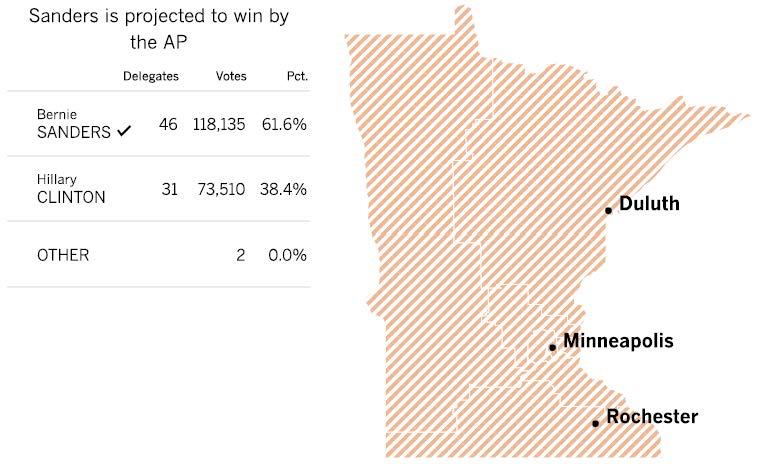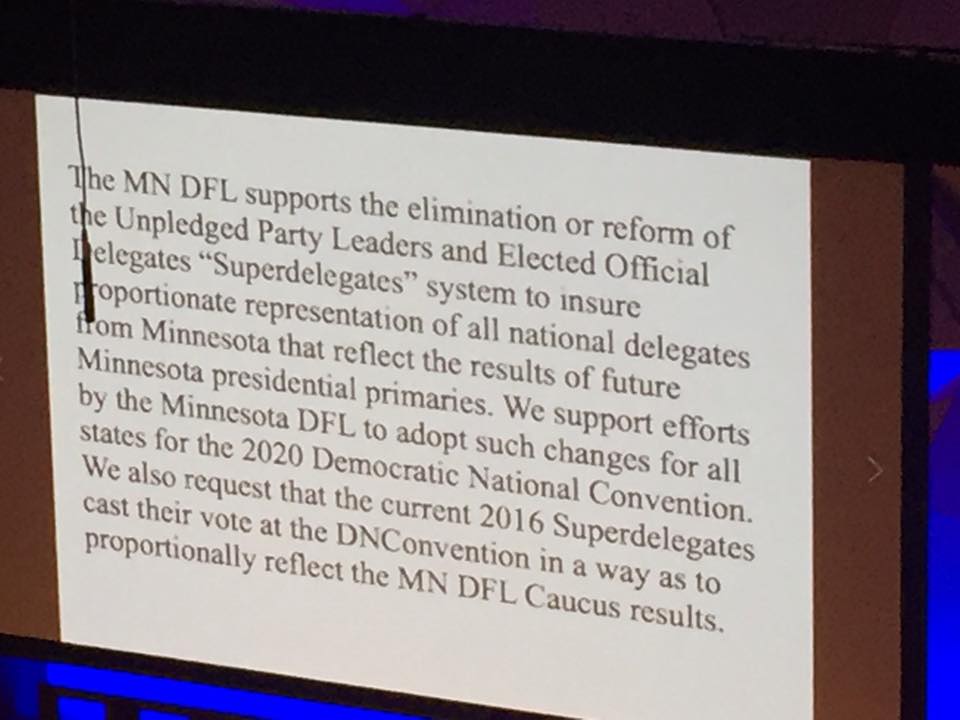Respectful wind siting NOW!
May 24th, 2018

The Red Wing Republican bEagle ran my commentary on wind siting, all of it! Short version? Respectful wind siting now! The community must consent!
Viewpoint: Respectful siting process for wind turbines long overdue
By Carol A. Overland, Red Wing
It’s taken a decade, but the Minnesota policy battleship is turning regarding siting of wind projects. State agencies, in their rush to site wind, have dropped the ball — they have failed in their charge to regulate and protect the public and the public interest. We need a respectful siting process, and that is 20 years overdue. If Minnesota doesn’t correct our wind siting process, the legitimate pushback will make siting a wind project difficult at best.
Recently an administrative law judge issued a recommendation that the Freeborn Wind Project be denied because it had not demonstrated it could meet the state’s noise regulation, or in the alternative, give the developers some time to demonstrate how it will comply with noise standards at all times throughout the project footprint.
The Public Utilities Commission will make a permitting decision, typically a month or more out. It’s not final, but this recommendation is a crucial step.
The Freeborn Wind case involves many “firsts.” It is the first project in Minnesota to be sited using the siting criteria of the Power Plant Siting Act (criteria in Minn. Rules 7850). It is the first project in Minnesota where the siting permit was subject to a contested case proceeding, in essence a trial, where the applicant had to prove up its application before an administrative law judge. It is the first project where an administrative law judge has recommended the permit be denied.
Lax rules
Minnesota wind siting has been lax and much of that falls directly on the Department of Commerce. The Environmental Quality Board no longer has siting authority. It’s been that way since 2005, when the Energy Omnibus bill shifted it to Commerce, doing siting “analysis” for PUC — in addition not to using Power Plant Siting Act criteria, and until now, no contested case.
There is no environmental review, no environmental assessment worksheet, no environmental impact statement, required for wind projects. Wind projects, until now, were separated out from the Power Plant Siting Act and permits issued citing the wind statutes and rules Minnesota Statute 216F and Minnesota Rules 7854, which have NO siting criteria at all? All wind siting permits cite only Statue 216F and Rule 7854 as permitting authority! That compartmentalization is the doing of the Department of Commerce.
There are small wind “standards,” which were ordered in 2008, but that was not a rulemaking. It was a process that was a too fast response to a legislative mandate, and in essence, the PUC took small wind standards and stamped them as “Large Wind Energy Conversion System” standards.
Nothing has been done since, despite pre- and post-construction complaints, suggestions, interventions and rulemaking petitions. State agencies, in their rush to site wind, have failed in their charge to regulate and protect the public and the public interest.
Issues are real
Wind projects are by definition the nuisance moving to the landowners. All are sited where there’s an established community, and the wind projects lease land in patchwork sites for their projects. Communities are steamrolled. The way projects are sited, it’s inevitable that homes are surrounded, and turbines are close to homes.
Noise issues are real. Noise modeling isn’t necessarily predictive, and siting often doesn’t allow for margin of error. Shadow flicker is real, but landowners are provided with blinds to live in the dark or are told to take a trip to Florida during times of heavy shadow flicker. Eagle nests are not accounted for, or in one case, blown away by helicopter, and in another, removed after getting a permit.
It’s time to develop thoughtful and respectful siting; It’s long overdue. We can establish standards and rules so that wind projects are projects people can live with. We can require modeling that provides for margin of error. We can take into account the feelings of non-participants who already live in the area and will be affected by a project moving in. The community must consent.
Looking forward, if Minnesota doesn’t alter siting regulations and practices, it’s going to be very difficult to site wind projects.
There’s also a problem looking backward, for there are people now living in the midst of improperly sited wind projects. Not only does Minnesota need to address siting issues, but Minnesota needs to develop policies for those living near and affected by wind projects, as has been done for other types of utility projects. There are at least two wind project permits now before the Public Utilities Commission regarding noise and
Minnesota’s noise regulation. Wind turbines are massive structures with 55-foot diameter concrete foundations — it’s not like we can just pick them up and move them.
Permits say that if there are violations, the violations must be corrected, or the permit can be suspended and/or revoked. In short, solutions to problems in existing wind developments are not easy, and few options are practical.
What to do? A start is to revamp Minnesota’s permit complaint process, which is occurring now in one docket. The revised complaint process, after public comment and a hearing, should be applied to all permits.
Another step is to enact an “opt out,” similar to the “Buy the Farm” option for transmission (Minnesota Statute 216E.12, Subd. 4, where affected landowners can make the utility buy them out rather than live under a transmission line.
Other ideas include a promulgation and revamp of PUC and MPCA rules, which is a multi-year process.
Policy takes a long time to change. Will Minnesota’s agencies, utilities, wind developers, landowners, and legislators work on the changes or will it be a continued fight? Do utilities want to site wind projects in Minnesota?
With the developments over the last year, I’m encouraged that Minnesota will work toward respectful siting. Let’s make it happen.
Carol A. Overland is a Red wing attorney who represents Association of Freeborn County Landowners.
p.s. Minnesota’s existing Wind Standards and Exhibit A.
Coal Ash rule gutting open for comment
March 8th, 2018
Coal ash, remember that big impoundment release, photo above, not all that long ago?
Good grief, it was a DECADE ago, and it’s still a mess. From the EPA page:
And another ash impoundment failure, our friends at Duke Energy, from EPA page:
EPA’s response to the Duke Energy coal ash spill in Eden, NC
It’s an issue in Minnesota too:
Who cares? Well, once a rule is proposed, there’s not much variation, because if there is, then it has to start all over again and go through this process. This is proposed to “amend” the 2015 final rule, so it can’t be good. Speak up NOW! Go to EPA’s Regulations.gov and make Comments under Docket ID No. EPA-HQ-OLEM-2017-0286 — open for 45 days after the proposed rule is published in the Federal Register, which is/was when? Figure it’s published NOW, and just do it.
From the EPA’s site, here’s the rule proposed to gut the 2015 final rule, because gutting regulation, that’s what this administration does:
And here’s the poop cut and pasted direct from the source:
Proposed Amendments to the National Regulations (Phase One)
On March 1, 2018, EPA Administrator, Scott Pruitt, signed the first of two rules that proposes to amend the April 2015 final rule. The proposal:
- Addresses provisions of the final rule that were remanded back to the Agency on June 14, 2016 by the U.S. Court of Appeals for the D.C. Circuit;
- Provides states with approved CCR permit programs (or EPA where it is the permitting authority) under the Water Infrastructure Improvements for the Nation (WIIN) Act the ability to set certain alternative performance standards; and
- Addresses one additional issue that has arisen since the April 2015 publication of the final rule.
EPA is proposing six provisions that would allow states or EPA the ability to incorporate flexibilities into their coal ash permit programs. These flexibilities would also be available to facilities with U.S. EPA-issued CCR permits.
Additionally, the proposal:
- Clarifies the type and magnitude of non-groundwater releases that would require a facility to comply with some or all of the corrective action procedures set forth in title 40 of the Code of Federal Regulations (CFR) in sections 257.96 through 257.98 in meeting their obligation to clean up the release.
- Adds boron to the list of constituents in Appendix IV of 40 CFR part 257 that trigger corrective action.
- Determines the requirement for proper height of woody and grassy vegetation for slope protection.
- Revises the current regulations to allow the use of CCR in the construction of final cover systems for CCR units closing pursuant to 40 CFR section 257.101 that are closing with waste-in-place.
- Adds a new paragraph to 40 CFR section 257.103 to allow facilities to qualify for the alternative closure provisions based on the continued need to manage non-CCR wastestreams in the unit.
EPA will be accepting written comments on this proposal through Regulations.gov under Docket ID No. EPA-HQ-OLEM-2017-0286 for 45 days after the proposed rule is published in the Federal Register.
Additionally, EPA will hold a hearing on this proposed rule. Additional information about the hearing will be posted in the docket for this proposal and on this website in the near future.
And more, cut and pasted from EPA:
UPDATE! Minnesota joins Washington State against tRump’s EO 13769
February 3rd, 2017

FRIDAY UPDATE: Court Order Halting tRump Immigration Action — Washington A.G.
From Geekwire – Press Conference on courthouse steps
Written ruling “soon.” Looking forward to that Order — covers the parts they challenged, the Constitutionally of parts 3 and 5, per AG’s Office.
On Monday, Washington State’s Attorney General, Bob Ferguson, filed a Complaint in federal court challenging the constitutionality of tRump’s Executive Order 13769, and a Motion for a Temporary Restraining Order to stop enforcement of this Order. Several jurisdictions have filed for, and received, restraining orders regarding particulars of that Executive Order, but this Washington State filing was the first generally challenging the Constitutionality of the Executive Order.
Thank you, Washington State, for posting these pleadings:
And just a bit ago, Minnesota’s Attorney General Lori Swanson joined our state with Washington State in suing Trump.
Read the Complaint, it’s a delight, particularly because it quotes from tRump’s campaign page where he lays out his intent to stop Muslim immigration — and it’s still posted on his site as of earlier today — what an idiot:
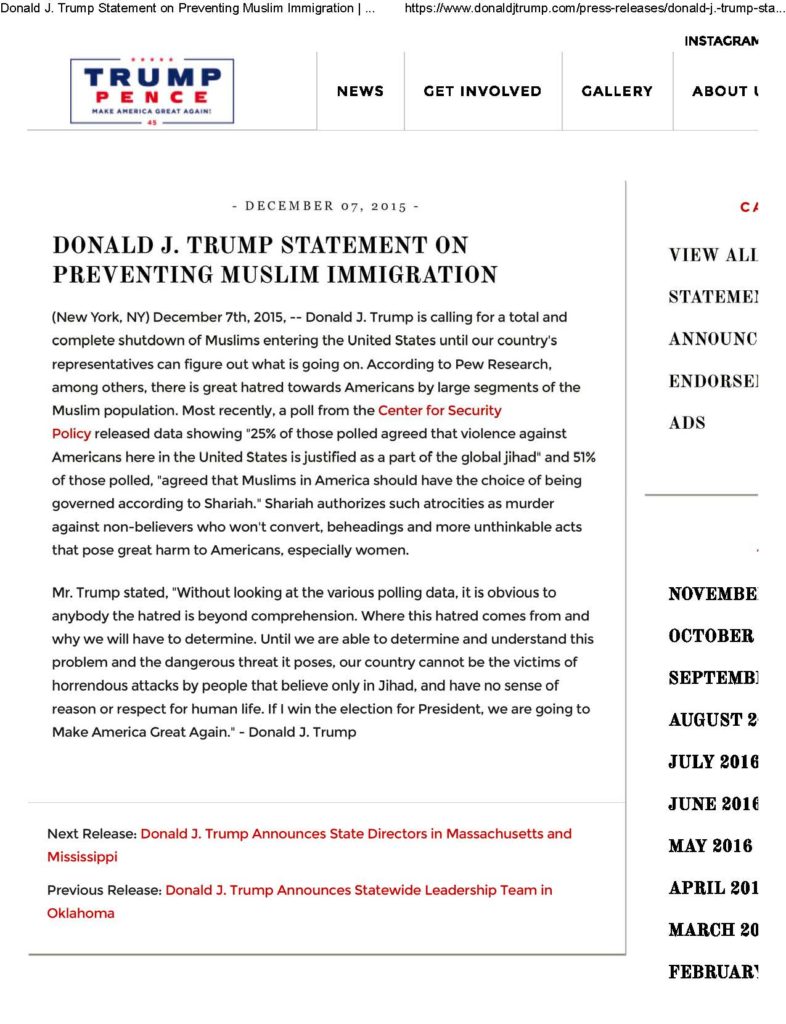
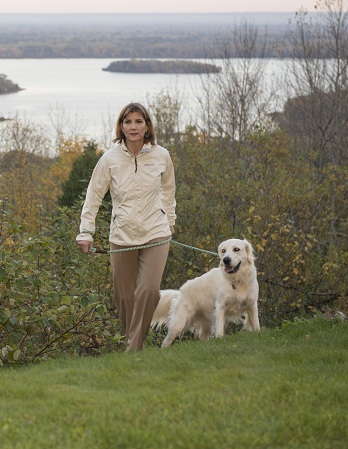
AG Lori Swanson (with Taffy, above) had this statement today:
Attorney General Lori Swanson Joins Lawsuit Over Federal Executive Order
Minnesota Attorney General Lori Swanson has joined a lawsuit against the federal government that alleges that the January 27, 2017 Executive Order that imposes blanket entry restrictions to the United States for people from certain countries is unconstitutional.
Attorney General Swanson said: “It does not pass constitutional muster, is inconsistent with our history as a nation, and undermines our national security.” She added: “America can keep its people safe without sacrificing bedrock constitutional principles.”
The Attorney General joined the lawsuit filed earlier this week by Washington State, which is supported by major corporations concerned about the impact of the travel ban on the economy and their employees. The lawsuit alleges that the Executive Order violates the equal protection, establishment, and due process clauses of the United States Constitution and the federal Immigration and Nationality Act of 1965, which prohibits discrimination in the issuance of visas on the basis of nationality, race, or place of birth or residence.
The lawsuit alleges that the Order is overbroad in imposing a blanket travel ban on people from certain countries “and sweeps within its ambit infant children, the disabled, long-time U.S residents, those fleeing terrorism, and those who assisted in the United States in conflicts overseas” who do not pose a security risk.
The lawsuit describes the impact of the travel ban on people with a lawful right to be in the United States, such as parents and their children, students with valid student visas, and scientists and other employees with valid work visas, who either cannot leave or return to the United States under the Order and some who have been separated from family. The lawsuit also describes the chilling effect of the Order on recruitment for employers and academic institutions.
Four different federal judges have temporarily halted certain detentions under the Executive Order.
Dept. of Health & 3M’s PFC/PFOA contamination
August 23rd, 2016
3M has gotten away with poisoning the water of Minnesota, and the Dept. of Health has taken some protective and/or remedial measures, but it’s not nearly enough. Isn’t it a wake-up call that we need a “Drinking Water Health Advisory” in this Land of 10,000 Lakes? Minnesota’s “Pollution Control Agency” has not been proactive on this, and we’ve known about 3M’s contamination for how long? This is why we need the EPA! The EPA is leading the charge, and Minnesota’s Department of Health (MDH), as above, has “responded” to the EPA Advisories.
80 Washington County homes will get bottled water as state reviews new pollution rules
In part:
The Dept. of Health page:
MDH Response to EPA Health Advisory for PFOS and PFOA
From the EPA’s page:
Basic Information
- Fact Sheet on PFOA and PFOS Drinking Water Health Advisories (May 2016)
- BLOG: Science Guides Public Health Protection for Drinking Water by Joel Beauvais
Technical Information
- FR Notice on the Health Advisories for PFOA and PFOS (May 25, 2016)
- 2016 PFOA Health Advisory
- 2016 PFOA Health Effects Support Document
- 2016 PFOS Health Advisory
- 2016 PFOS Health Effects Support Document
- 2016 EPA Response to Peer Review Comments
Provisional Health Advisories and Draft Health Effects Documents
Technical documents
- 2009 Provisional Health Advisory
- 2014 Draft Health Effects Document for Perfluorooctanoic Acid (PFOA)
- 2014 Draft Health Effects Document for Perfluorooctane Sulfonate (PFOS)
- Peer Reviewer Summary Report: External Peer Review of EPA’s Draft Health Effects Documents for Perfluorooctanoic Acid (PFOA) and Perfluorooctane Sulfonate (PFOS)
Peer Review
DFL Convention yesterday
June 5th, 2016
Yesterday was the DFL State Convention, and it was a long, long day on not enough sleep. I distinctly recall seeing the clock a little after 1 a.m., and the 6:45 a.m.alarm never went off. A Convention is right up there with a root canal (which I WON’T do), so with all due haste I got my butt into the van and headed north. Orchestra Hall? I haven’t been there since Dexter Gordon, so you know how long ago that was!
Amid divisions, DFL leaders target Trump at state convention
Registration was an exercise in planning ineptness. They ran out of registration forms. Sound familiar? Yeah, it’s like running out of ballots! There is a set number of delegates and alternates, so why were there not sufficient registration forms? I found one laying on a table, SCORE!
At registration, there’s a “voluntary” fee of $50 when pre-registered, and $65 at the door, but given how the party is pushing Hillary despite the state’s Sanders win, no, I’m not about to give the DFL money — Bernie gets my donations. And so after winding through a long, long amorphous line, I finally got to the front of the line, said, “I’m here and I’m broke (I did have $1 and some change in my pocket)” and she said, “That’s OK, we love you anyway” with such sincerity! Her attitude was a day brightener!
After registering, we had to go over to a different alphabetical section to pick up our credentials, and that was another YUGE line, well, many YUGE lines, and the good news was that the letters didn’t mean anything, we could jump to an open line. I got registered, got my credentials, and got to the “Alternates” balcony (Alternates are not allowed on floor). I later heard from others there were not enough blue bags with convention materials. The Alternates section was up in the balcony… not long after I arrived, I was shuttled further up, to the THIRD FLOOR balcony, the second tier balcony, way, way up in the nosebleed section.
I sat through a few speeches, and jumped right on Gov. Dayton and Sen. Klobuchar when they brought up Hillary. BOO HISS! Why raise their support of the LOSER in Minnesota? They should know better when the state went for Sanders by a landslide, 61.6% to 38.4%, with Bernie winning in every Congressional District:
Both Gov. Dayton and Sen. Klobuchar chose to bring up their support for Hillary, and they got the response they deserved, and then had the nerve to plea for “party unity” that followed their Hillary support. Oh, please… Their choice to be divisive and ignore the landslide support of Sanders in Minnesota could have, should have, been different. Bad choice. SHAME! A few rounds of BOO-HISS is fully appropriate. And for them to then pile on with “we need unity,” give it a rest. They chose their divisive promotion.
There were co-chairs in charge. O’Brien as a chair appeared at times unsure, confused and maneuvering/directing the process, but also not firm enough with the group and from my perspective, making some bad calls. Melvin Carter was more direct and firm, pushing the process along. It was so slow…
Just as I was getting ready to leave after a couple hours of these speeches that were so manipulative, I got word that I was being “upgraded” and to get ready to be a delegate and be seated with the Goodhue County group in the front row. Another point of disorganization, we were assigned 7 seats for 9 delegates. WTF? This was a common problem raised by others that day, seats were assigned and there were not enough assigned seats. They know how many delegates are allotted, so why this crap?
SNORT of the day: When St. Paul’s mayor was introduced, and we were urged to welcome him, the captioning said, “POLICE WELCOME ST. PAUL MAYOR CHRIS COLEMAN.” Really… after the 2008 RNC, no surprise there!
There was a Motion for “A Sense of the Convention” or some such, which had two parts, first, that the superdelegate system should be scrapped/reformed, and second, that at the 2016 national convention, the superdelegates should not vote or should vote according to MN caucus results:
This received a resounding YES! in proportion to Bernie v. Hillary supporters. It took quite a while to get to the vote, and recount, but finally, YES! Hope that will be heard by the superdelegates.
Most notably, there were not enough copies of the Resolutions on which we were supposed to vote. When voting time came, there was a call from the chair for people to pass on their copies to those who didn’t have them. Sharing is good, but copies of documents we’re voting on is a pretty basic need and they should have been prepared. The number of delegates is known, alternates didn’t get the bag of materials, so why were there not enough? And in the email to us, they could have told us to print them out and saved on copies by asking if we needed copies at registration. Then it gets worse, “some” resolutions were taken off the ballot after the resolution ballot was sent pre-convention and after they were printed for convention packets, and somehow referred to the Central Committee! Which ones? Well, no one was saying, and it took repeated pushes to get that info. What bullshit. What resolutions were they? 24, 32, 41, 54, and 60! Numbers only. Great… What were they?
24. Support legislation (such as tax credits, loan forgiveness programs, and refinancing) to reduce Minnesota’s student loan debt.
32. Support legislation that requires all crude oil pipelines transiting Minnesota to have Environmental Impact Statements (EIS), to have financial assurances for spill and abandonment cleanup, and respect sovereign native territory.
41. Support health care as a basic right for everyone in our society, and take steps to ensure that everyone is able to receive a niminum level of health care including physical, mental and dental care.
54. Oppose sulfide ore mining, which is significantly different from taconite mining, poses unacceptable environmental risks, threatens multiple watersheds (Lake uperior, BWCA/VNP, Mississippi) and should not be allowed in the sulfur bearing rock of Minnesota.
60. Oppose fracking because of its damage to the environment and the resulting burden on future generations.
Interesting combo there… This finagling is a problem.
Then, when it was time to vote on delegates to the DNC Convention in Philly, the set up at Orchestra Hall was poor. What were they thinking? On the other hand, SNORT, as reported in the STrib:
For the Sanders delegate elections, it took a while to get a moderator, but moderating was handled well. First, there was no procedure or a complete list of those who were running. WHAT? So that had to be established…
And then we started with a poor play by Sanders crew — they proposed a slate of 10 delegates, and 2 of them weren’t even present! Oh my… bad move. And that was soundly rejected. We did get the 8 of them onstage, but at that time, we didn’t even get any info about them other than their names. No one who doesn’t show should be allowed to be a national delegate. The group soundly rejected this slate (who all were allowed to be part of the following delegate cattle call). I hope the campaign got the message, though I’ll send them one directly too.
For the potential national Bernie delegates, there would be 9 women and 7 men, and 4 alternates. For applicants, there was only a sheet from THURSDAY (!?), on a Saturday, in teeny tiny print with just under 200 names, and many more applied after Thursday, so for sure over 200 were wanting to be national delegates. That’s a lot! Essentially, 10% of those who wanted to be a delegate would be selected.
After spending at least an hour, maybe two, nailing down the delegate selection process, we had a parade of delegates. This was the best part of the day. The parade of delegates was the most diverse, devoted, dedicated bunch ever. Some were brand new to voting and politics, some were grizzled old farts, some were long-time dedicated party workers, some wore suits, some wore shorts (“I’m the short guy in shorts!” said one), some Native, some first generation immigrants, some new to Minnesota from other states, some L or B or G or T or some mix of identification, some small business owners, some disabled, some union members (Teamster & Stagehands 13), some urban, some suburban, some rural, some students, like wow! Their allotted 30 second elevator speeches were great, inspiring. THIS is what DEMOCRACY looks like. This group was Minnesota, the essence of our state, and made me so proud to be Minnesotan and part of this Convention. I can’t say enough good things about this group of Bernie supporters. Looking forward to hearing who all was selected. Oh, here’s the list:
1. Muhammad Abdurrahman
2. Gabe Aderhold
3. Michael Gibino
4. John Neitge
5. Frank Hornstein
6. Keith McClain
7. Will Moore
A1. Michael Bearfoot
A2. Jacob Mazurek1. Yishu Dài
2. Mara Glubka
3. Shakia McDavid
4. Erika Onsrud
5. Shauna Kaylene Wimmer Valdez
6. Margaret Breen
7. Nelsie Yang
8. Lisa Bender
9. Ashley Fairbanks
A1. Fartun Weli
A2. Susan Wolfe
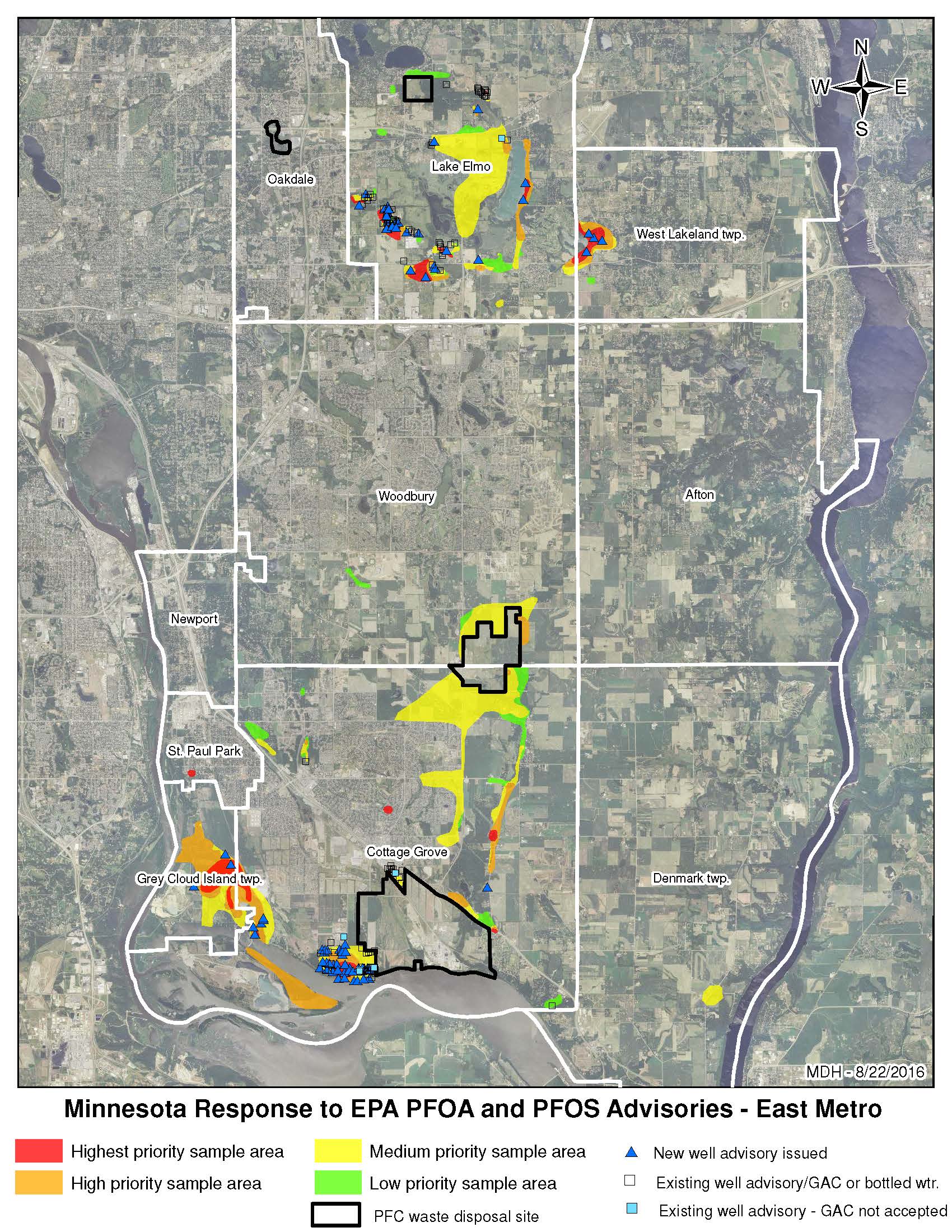
![20160604_094529[1]](https://legalectric.org/f/2016/06/20160604_09452911-576x1024.jpg)
